Young challengers take a deep dive into engineering
Broadcom MASTERS finalists had to create remotely-operated vehicles that performed a underwater task
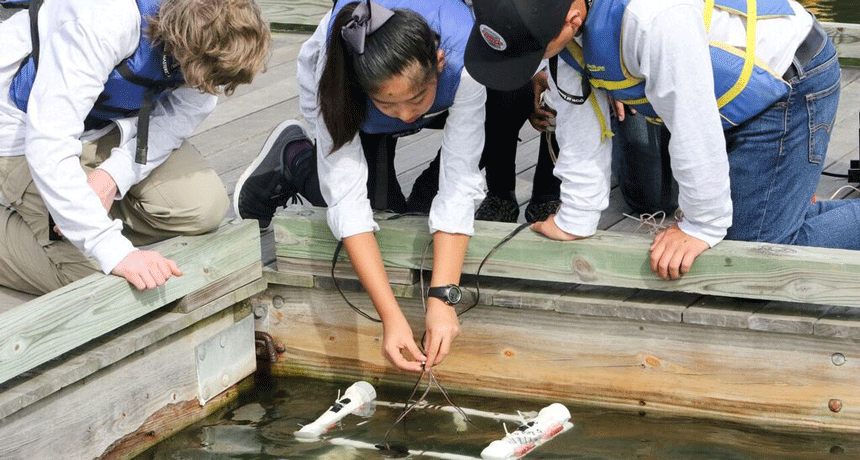
Broadcom MASTERS finalists on the Silver Team test a remotely-operated vehicle they designed and built to collect sediment from a river bottom.
Linda Doane/SSP
By Sid Perkins
WASHINGTON, D.C. — Sometimes a job is too dirty, dangerous or downright impossible for a human to tackle. That’s often when engineers build a machine to take on the task. Finalists at this year’s Broadcom MASTERS competition were presented with just such a challenge. They had to design and build a small remotely-operated vehicle (ROV) that could dive to a river bottom and bring back a sample of the sediment. Adding to the challenge, they had only a few short hours to do it.
Broadcom MASTERS brings together 30 middle-school finalists each year for a special competition. (MASTERS stands for Math, Applied Science, Technology and Engineering for Rising Stars.) The program was created by Society for Science & the Public, which publishes Science News for Students. Broadcom Foundation, based in Irvine, Calif., sponsors the event. The top winner, this year, took home an educational award valued at $25,000. Others took home smaller, but still substantial, prizes.
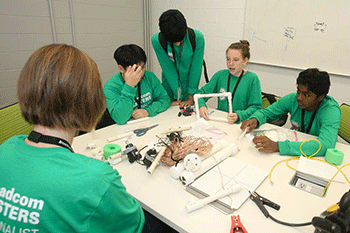
In contrast to most science competitions, roughly three-quarters of a finalist’s score at this event comes from how well he or she innovates and works within a team. Only about one-fourth of a finalist’s total score reflects the science-fair project that qualified each for the competition (and which they presented to judges earlier in the week).
This year, each of the six teams of finalists faced stiff challenges. They built electronic circuits that lit up when a rolling ball completed the circuit. They devised ways to filter tainted water “on Mars.” But their final and most demanding test was creating a sediment-collecting ROV.
The task at hand
Engineering is a process that uses math, science and practical knowledge to invent, design, build and improve structures, machines, materials and more. This year’s toughest challenge for Broadcom MASTERS finalists required them to tap into their inner engineers.
They worked at the Smithsonian Environmental Research Center, or SERC, in Edgewater, Md. This center sits along the shore of the Rhode River, a short waterway that flows into the Chesapeake Bay. When last year’s group of Broadcom MASTERS finalists went to the site, they built a robotic arm based on a crab’s claw. This year’s group had an equally hands-on task.
Whitman Miller, an environmental scientist at SERC, gave the finalists background on their mission. He has worked with engineering students at the nearby U.S. Naval Academy to design and build a small unmanned craft that can sail near to shore. It doesn’t have one hull that extends deeply into the water. Instead, it has three hulls that are connected in an arrangement that looks like an outrigger canoe.
That craft is not yet finished. Indeed, its final design is “up in the air,” so to speak. Still, Miller has a few ideas about how it will look when complete.
Motors that propel and steer the craft (and the batteries to power them) will sit in the smaller hulls on each side of the main one. That main hull in the center of the craft will likely carry scientific instruments, including sensors. It also will carry navigation equipment along with the small computers needed to control the sensors. Miller and his team will be able to swap out sensors and other equipment, depending on which task the craft is dispatched to tackle.
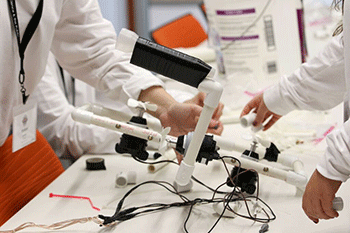
When done, the craft will be able to carry out missions without human input, says Miller. For example, it might collect sediment from shallow waters near shore. Such areas are usually inaccessible to large boats, which have hulls too deep to sail there. The craft might use a global positioning system (GPS) to navigate. No human assistance would be needed as the craft operates. Such programmable, hands-off vehicles are called autonomous (Aw-TAH-nuh-mus). Sometimes researchers send out autonomous underwater vehicles, or AUVs, to perform repetitive tasks, such as mapping the seafloor.
Other types of underwater vehicles are designed to go where crews at the surface guide them, Miller notes. These ROVs usually are controlled via signals sent to the craft along wires. Sometimes, images from cameras or data gathered by other sensors on the craft flow back to the people controlling the craft. That sort of real-time feedback can help controllers guide the craft throughout its mission.
ROVs have explored shipwrecks, such as the Titanic. They’ve also been used to explore the ecosystems around deep-sea hydrothermal vents.
The Broadcom finalists’ task would be a lot simpler. They had to design an ROV that would dive a little more than 2 meters (about 7 feet) beneath the water’s surface and bring up a sample of sediment from the river bed. After Miller’s brief intro, the finalists got a look at the materials they could use to build their vehicles.
Down to work
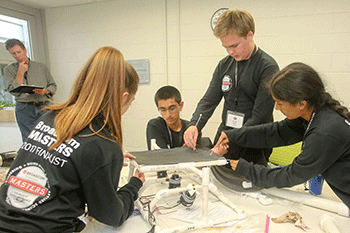
The finalists worked in teams of five. Each was named for a color. (The finalists had been assigned to those teams before they arrived in Washington. And each of these groups had already worked on challenges as a team at this year’s competition.)
Each team was supplied a bucket of parts. There were rolls of tape and pieces of plastic pipe of various lengths, along with some L-shaped and T-shaped plastic connectors. The young engineers also got spoons and sponges, which could be used to pick up sediment. Among the most important things in the bucket were a trio of small motors, a switchbox to control them and a battery pack to power them.
The teens initially spent about a half hour designing their ROVs. Next, the teams took a short break for lunch. Although, for most teams, lunch wasn’t much of a break. Many competitors spent a lot of that time discussing and tweaking their design.
Afterward, the students were given 90 minutes to build — and, in some cases, tear apart, rebuild and build yet again — those ROVs. Some ended up with a box-like configuration. Others looked more like a picture frame with an arm sticking out and holding a scoop.
The building phase was challenging. The teams were working in an office building far from water. They had no idea whether the device they were assembling would float like a boat or sink like a rock. They also couldn’t tell whether their ROV would be balanced and level in the water, or if it would tilt strongly to one side. Such issues could affect where on their ROV the team placed its motors.
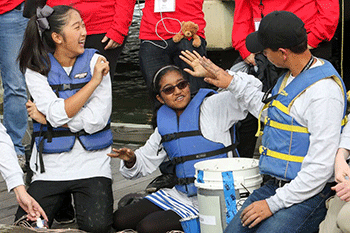
Finally, the teams were shuttled down to SERC’s dock. There they got a chance to test their vehicles. On this cloudy yet calm day, each group claimed a short stretch of dock. From there, they eased their ROVs into the water. Over the next 90 minutes or so, the teams continued to tweak their designs. This time they made changes with clear evidence of their ROVs’ abilities — or lack thereof.
In some cases, the engineers might ditch a plan to scoop sediment with a spoon. Instead they’d redesign the system — successfully — to collect sediment with a sponge. One team’s frame-shaped design was poorly balanced at first. The students struggled to arrange their motors. Eventually — after quite a few tries — they found a design that worked.
In the end, every craft brought up at least a small bit of the Rhode River’s fine-grained sediment.
As each team later described its design to the others, the students shared some of the lessons they would take home. These included: “Never let go of an idea, even if it doesn’t work right away.” “We found several ways to collect sediment that worked.” “Our design doesn’t look great, but it works!”
Karen McDonald is an environmental scientist at SERC. She hosted and led the ROV challenge. After the teams had briefed each other on their prototype vehicles, she praised them for their efforts. “I saw some great teamwork and some great designs,” she said.
SERC’s Miller agreed: “I was impressed with what the teams were able to do in just three hours,” he said. “Technology is moving so quickly now, but it’s also more accessible to people who aren’t professional engineers.”







